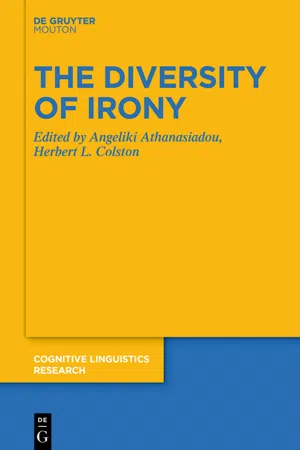Languages & Linguistics
Hyperbole
Hyperbole is a figure of speech that involves exaggeration for emphasis or effect. It is often used in literature, poetry, and everyday speech to create a dramatic or humorous effect. Hyperbole can be used to make a point, to evoke strong emotions, or to create a memorable image.
Written by Perlego with AI-assistance
Related key terms
3 Key excerpts on "Hyperbole"
- eBook - ePub
Writing on the Edge
Paul's Use of Hyperbole in Galatians
- Charles E. Cruise(Author)
- 2019(Publication Date)
- Pickwick Publications(Publisher)
2556 .Due caution should be exercised when crossing the so-called hermeneutical bridge. Modern understandings of a phenomenon such as Hyperbole may not entirely comport with ancient forms or usage. There may be differences that are worthy of recognizing and bearing in mind. These will be duly noted in the ensuing chapters.I also wish to prepare the reader for the fact that the theoretical literature I will be reviewing in this chapter may at times be technical or cumbersome, especially for those without a background in linguistics. I will do my best, however, to explain things as clearly as possible and to avoid unnecessary rabbit trails. I will also work from examples in order to provide concise demonstrations of my outworking of theory into practice.Definition of HyperboleHyperbole is a deliberate exaggeration for the sake of effect. The term derives from the Greek ὑπερβολή (verb form ὑπερβάλλω , originally meaning “to cast beyond,” as in a spear contest [BDAG]). In Latin it is known as superlatio . According to Neal Norrick, “Hyperbole is an amplificatio , a vertical-scalar metaphor. . . . An amplificatio says more than necessary or justified . . . either through repetition . . . or through lexical substitution.”256 - eBook - ePub
- C. John Collins(Author)
- 2018(Publication Date)
- Zondervan Academic(Publisher)
14 Alan Millard, familiar with historiographical conventions from the ancient Near East, suggests that Hyperbole is well-attested, and there is no reason to resist finding it in the Bible:To speak of Solomon’s wealth as so great that silver had no value, “as common in Jerusalem as stones” (1 Kgs 10:27), is oriental Hyperbole of exactly the same sort as the assertions by indigent Mesopotamian kings who wrote to the Pharaoh, “Gold is like dust in your land, one simply scoops it up” (El Amarna Letters 16, 19, 20, 29). The writers were describing unusual riches in phrases that convey the thought clearly enough, without demanding a literal interpretation.15The Christian pastor John Stott (1921–2011) serves as an example of someone using good sense in the way he intuitively discerns some of the rhetorical tropes in the Bible. In his popular commentary on the Sermon on the Mount,16 he identified a paradox in the form of the Beatitudes: “Happy(blessed) are the unhappy” (on Matt 5:4). Its function is to draw attention to the way Jesus “contradicted all human judgments.”17 He also recognized, without using the terms, that the instruction “do not let your left hand know what your right hand is doing” (Matt 6:3) is either Hyperbole or adynaton: “Of course it is not possible to obey this command of Jesus in precise literalness.”18 - eBook - ePub
- Angeliki Athanasiadou, Herbert L. Colston, Angeliki Athanasiadou, Herbert L. Colston(Authors)
- 2020(Publication Date)
- De Gruyter Mouton(Publisher)
The cases of never and always showed that, in Hyperbole, there is not only just a shift and adjustment on the scale between what is said and what is meant. Attitude and exaggeration are part of the input in Hyperbole – an exaggeration of a state of affairs informs the input, specifically the choice for what is being contrasted against. In Hyperbole there is no distinct isomorphic pairing of linguistic forms to hyperbolic meanings. Hyperbolic meanings are dependent on a salient contrast (and where it lies) as well as the nature of that contrast relative to a speaker’s attitude and that speaker’s subjective evaluation. It is informative to look at borderline examples. When is tiny hyperbolic? It is hyperbolic the more its use moves away from objective to subjective assessment. It is hyperbolic when used to describe something that is smaller than expected or wanted (thereby creating a salient contrast). In general, the production of Hyperbole aims for the portrayal of some subjective attitude, while the comprehension of Hyperbole is to pick up on that attitude. References Brdar-Szabó, Rita & Mario Brdar. 2010. “Mummy, I love you like a thousand ladybirds:” Reflections on the emergence of hyperbolic effects and the truth of Hyperboles. In Armin Burkhardt & Brigitte Nerlich (eds.), Tropical truth(s): The epistemology of metaphor and other tropes, 383–427. Berlin & New York: De Gruyter. a, b, c, d, e Cappelen, Herman & Ernie Lepore. 2005. A defense of semantic minimalism and speech act pluralism. Malden: Blackwell. → Carston, Robyn & Cathering Wearing. 2015. Hyperbolic language and its relation to metaphor and irony. Journal of Pragmatics 79 (May). 79–92. http://doi.org/10.1016/j.pragma.2015.01.011 (accessed 6 May 2016). a, b Colston, Herbert L. 2015. Using figurative language. New York: Cambridge University Press. a, b, c Colston, Herbert L. & Shauna B. Keller. 1998
Index pages curate the most relevant extracts from our library of academic textbooks. They’ve been created using an in-house natural language model (NLM), each adding context and meaning to key research topics.


